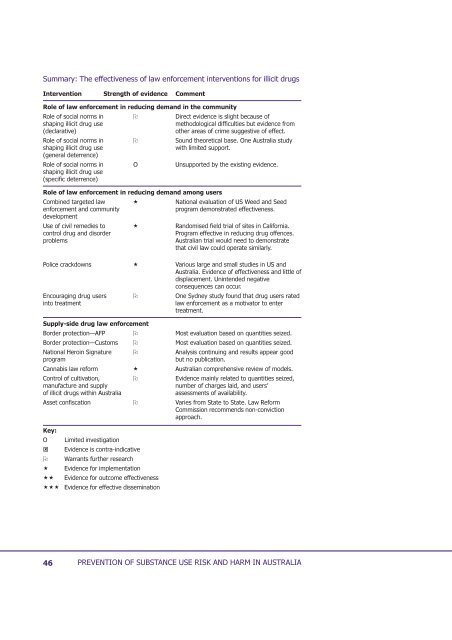Summary - Department of Health and Ageing
Summary - Department of Health and Ageing
Summary - Department of Health and Ageing
You also want an ePaper? Increase the reach of your titles
YUMPU automatically turns print PDFs into web optimized ePapers that Google loves.
Controlling drug supply from within the country<br />
Control <strong>of</strong> supply within Australia is undertaken mainly by State <strong>and</strong> Territory police<br />
services. The main drugs <strong>of</strong> interest are cannabis <strong>and</strong> amphetamines. Cannabis is cultivated<br />
on a large scale Australia-wide <strong>and</strong>, while aerial surveillance has reduced the crops grown<br />
outdoors, hydroponic cultivation flourishes.<br />
Almost all States <strong>and</strong> Territories now have policies or legislation to reduce penalties for<br />
cannabis use <strong>and</strong> possession, thereby also reducing backlogs in the justice system.<br />
Measures include cautioning <strong>and</strong> diversion programs <strong>and</strong>/or changes to the legal status <strong>of</strong><br />
cannabis.<br />
Cannabis law reform is grounded in a recognition that while cannabis use can be<br />
physically <strong>and</strong>/or mentally harmful, a proportion <strong>of</strong> the harms are related to its illegal<br />
status, which has done little to reduce use—in short, that decriminalisation is associated<br />
with less harm than a criminal model. There is little evidence that the different legislative<br />
models in place in Australia <strong>and</strong> overseas have any significant effect on levels <strong>of</strong> cannabis<br />
use. This introduces the attractive possibility that reducing penalties might reduce harms<br />
while not increasing rates <strong>of</strong> use.<br />
The use <strong>of</strong> amphetamines continues to increase in Australia <strong>and</strong>, during 2000–2001, 201<br />
cl<strong>and</strong>estine laboratories were found, most producing methylamphetamine. One approach<br />
is to control precursor chemicals, the starting compounds or ingredients that, when<br />
combined with other essential chemicals, produce illicit drugs—in Australia, these are<br />
predominantly amphetamines. All State <strong>and</strong> Territory police services have now established<br />
chemical diversion desks to monitor suspicious purchases <strong>of</strong> precursor chemicals<br />
(currently concentrating on pseudoephedrine-based tablets such as Sudafed) <strong>and</strong> liaise<br />
with the chemical <strong>and</strong> pharmaceutical industry. There are no indications that these<br />
processes have, as yet, reduced the domestic manufacture <strong>of</strong> amphetamines.<br />
Asset confiscation<br />
All Australian jurisdictions have legislation dealing with the confiscation <strong>of</strong> the proceeds <strong>of</strong><br />
crime. There is a debate as to whether this asset forfeiture should be conviction-based (i.e.<br />
requiring pro<strong>of</strong> beyond reasonable doubt <strong>of</strong> criminal activity) or non-conviction-based<br />
(i.e. pro<strong>of</strong> to the civil st<strong>and</strong>ard <strong>of</strong> the balance <strong>of</strong> probabilities). The Australian Law Reform<br />
Commission has recommended non-conviction-based legislation, <strong>and</strong> this is now in place<br />
in at least three States. It is difficult to compare conviction <strong>and</strong> non-conviction regimes to<br />
determine their effectiveness because there are no national reporting st<strong>and</strong>ards.<br />
<br />
While additional research is needed to assess the effectiveness <strong>of</strong> illicit drug law<br />
enforcement, the difficulties <strong>of</strong> research in this area should not be underestimated. The<br />
nature <strong>of</strong> law enforcement is such that some operations <strong>and</strong> some data have to remain<br />
confidential. Recent years have seen a shift towards more detailed evaluation <strong>of</strong> Australian<br />
drug law enforcement, together with new research into the illicit drug market. This should<br />
enhance the scope <strong>and</strong> depth <strong>of</strong> the evidence base that shapes Australian illicit drug law<br />
enforcement.

















